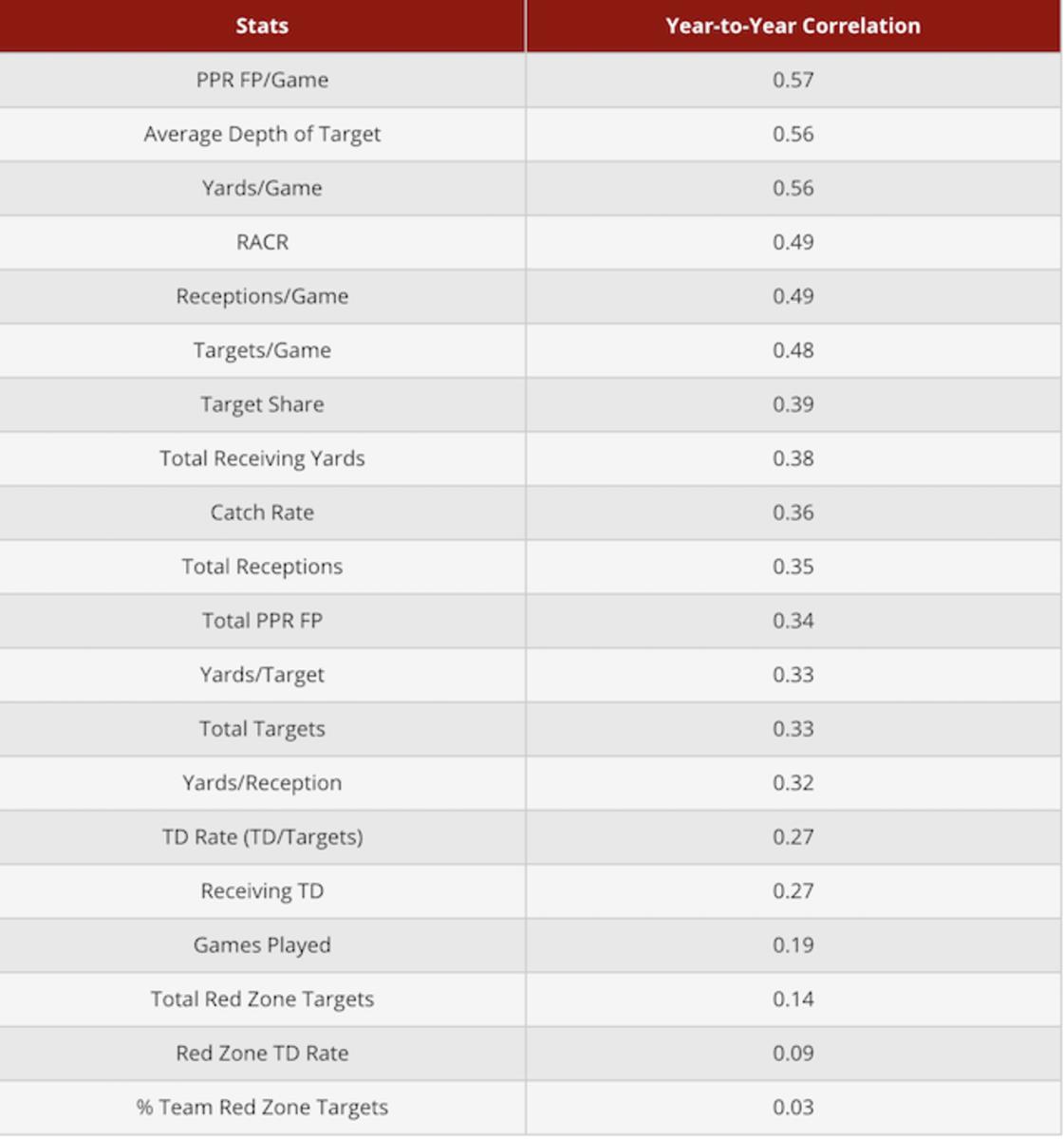The Most Predictable Tight End Stats

One of the main data points in fantasy football draft prep is every player’s performance in the previous season. Looking strictly at past performance rather than using history to make hypotheses about the future is a fool's errand. The goal of this study is to uncover which frequently referenced previous-year stats for tight ends are reliable indicators of future performance, and which ones may be misleading.

Methodology
In hopes of keeping this study somewhat controlled, only tight ends that saw at least 65 targets in a season and remained on the same team in consecutive years since 2010 were considered. So many variables change from one year to the next in the NFL, and a study like this can be inherently sensitive to outliers. Eliminating something as drastic as a team change should remove some noise. Sixty-five targets is an arbitrary cutoff, but should be sufficient enough of a sample to gauge a player's performance level in a season. This methodology resulted in a sample of 94 instances in which a tight end met the volume threshold in consecutive seasons for the same team.
The Most Predictable Running Back Stats
The following table gives the correlations for 20 statistics that are commonly cited when trying to project a tight end's upcoming season:
Year-to-Year Statistical Correlations for TEs on Same Team in Consecutive Seasons (since 2010, min. 65 targets)

Per-game stats have the strongest year-to-year correlations for tight ends. When you consider that these stats simply represent a player's average performance, this should come as no surprise.
On the other hand, volume stats will fluctuate if a player misses a handful of games. The correlation of games played from one year to the is weak, although it should be noted that it is significantly stronger than at any other position.
Premium Draft Prep Tools from 4for4: Draft Analyzer | Customizable Cheat Sheets | LeagueSync | ADP Bargains | Learn More About 4for4
Stats that Stood Out
We know fantasy football is a volume game, and targets and receptions per game are among the most consistent year-to-year-stats for tight ends. In turn, tight ends generally put up very reliable yardage numbers, attributable to their incredibly sustainable average depth of target (aDOT). We’ll have more on this a bit later.
What really stands out, though, is how consistent tight end scoring is from year to year. Tight end is more consistent than any other position in terms of year-to-year fantasy scoring.
Fantasy Football 2018: Tight End Primer
Additionally, tight ends seem to be either the most likely skill position to maintain their role in an offense, the least injury-prone, or both. While all other positions saw virtually no correlation in games played from one year to the next, there is some correlation with tight ends, albeit weak.
Using Air Yards for Fantasy Success
Earlier this offseason, Josh Hermsmeyer explained the importance of air yards as it pertains to predicting fantasy football success—specifically looking at aDOT and Receiver Air Conversion Ratio, or RACR. In short, we want to find out how efficient a player is at their most common depth of target. RACR captures just this and, combined with aDOT, can measure a player's receiving yards with great confidence. Only PPR points per game are more stable for tight ends from one year to the next than aDOT, and RACR is one of the more reliable metrics, making Josh's method of projecting production a viable one for anyone who wants to run their own projections against the public.
The Most Predictable Wide Receiver Stats
The Red Zone is Not Reliable
Although tight ends are often thought of as dominant red-zone threats, the fact of the matter is that they don’t see nearly the volume of targets near the goal line that wide receivers do. In 2017, just four of the top-16 players in red-zone targets were tight ends.
Since only a select few tight ends see any significant red-zone volume, their year-to-year red-zone efficiency as a group is extremely volatile. We should use tight end red-zone scoring rates and market share numbers to decide if a player is expected to regress to the mean, rather than as a sign of things to come.
How Not to Lose Your Fantasy Football League in the First Round of Your Draft
Bottom Line
When considering how a tight end performed in one year in hopes of applying that data to the next season, there are a few key points to note:
In PPR scoring, year-to-year fantasy points correlate stronger for tight ends than any other position.
Tight ends tend to maintain their target volume from one year to the next.
Air yards and target depth have proven to be among the most stable year-to-year metrics and can help predict yardage output for tight ends.
Most tight ends tend not to see much red-zone volume, so their efficiency metrics can swing wildly from year to year. Tight ends with consistent red-zone work are very valuable commodities.
